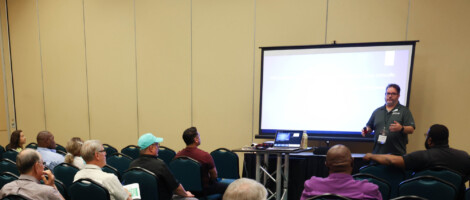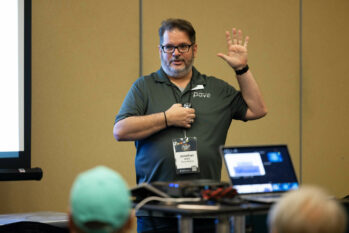Revitalizing churches requires truth-telling, community engagement
by Teresa Young on July 18, 2023 in Annual Meeting

If your church is declining in attendance or plateauing for several years, there is good news: You are not alone. But the better news is you don’t have to stay that way, said Dr. Jonathan Smith, Director of Church Health Strategy for Texas Baptists.
In a Tuesday morning workshop at the 2023 Texas Baptists Family Gathering in McAllen, Smith shared opening steps to church revitalization for those who find themselves in this shrinking ship. But first, realizing a few truths come with the process, Smith urged.
“First, there is a mindset we must have: Your church is not in competition against another church in your community. Your church is a competition against the darkness,” Smith said. “No matter what size your community is, there are plenty of lost people around you. You have to run into those dark places with the power of the Holy Spirit.”
Smith also noted churches cannot do too much mission work and focusing on kingdom work will result naturally in church growth. He shared statistics showing church attendance has been plateauing or declining in 80-90% of churches even before the pandemic. Post-pandemic, the decline has been accelerated, with most posting a 25% average decrease.
With the state population projected to nearly double by 2050 and nearly 900 churches closing annually, Smith encouraged churches to hold strong and embrace revitalization so they can embrace this growing Texas.
Smith then shared four steps to start the revitalization process, starting with truth-telling, which he defined as presenting the problem as it stands and the possibility of what could be. He encouraged starting with a 10-year report of both worship and Bible study attendance charted in a visual that allows members to see patterns and develop a sense of urgency for change. He suggested a chart with baptism numbers and budget receipts for 10 years and the completion of a Church Health Survey.

Secondly, Smith urges reengagement with the community to begin building relationships and to get the church outside its walls. Completing seven interviews with key city leaders with two simple questions can help churches find areas where they can fill gaps.
“We suggest asking, ‘From your unique perspective, what hidden issues or problems exist in our community? How could our church address these issues?’” Smith said, noting that the seven interviews must include a pediatrician, one or two teachers, a police officer or firefighter and a counselor or social worker. The remainder can be general physicians, school administrators, hairdressers, ER doctors and other pastors, with city officials lower on the preferred list.
Smith’s third key is to raise the morale of the congregation by showing what the church can become. He used the example of baptisms, encouraging a few changes to highlight the life-change among members and moving the ordinance to the end of the service (so you don’t miss the late-comers); only baptizing one person per service; announcing the baptism the Sunday prior; including a short video testimonial of the member played before the baptism; and recording both for replay the following Sunday with a celebration tradition of some kind.
He said morale can also be raised by hearing reports on mission work – spread out over several weeks instead of in one service – and by introducing new members the same way. The key, he said, is focusing weekly on life change.
The final step, Smith said, is to “get leaders in forward-facing seats.” He explained that every congregation has four groups of members: Young and new members; older and new members; young and tenured; and old and tenured. Those last two groups are historically the most resistant to change, Smith said.
“But those are often the people we put in the most important leadership roles, and they will not lead the church to change. The longer you are at a church, the less you see the need to change, and that goes for members and maybe for pastors,” Smith said. “Flip the script.”
Smith offered assistance through his Texas Baptists office and a program called PAVE, which walks churches in need through the process from eye-opening research to small and big steps of change to the “right-side up” model where the mission is the focus and the structures and programs all support that. He said the program is growing and involving more churches, and he’s encouraged by the enthusiasm and the urgency pastors have.
“Over time, churches grow fast, but when they fall, they fall fast. Even if the church has just plateaued for five years, you have to treat it like the house is on fire,” he said, but encouraged patience and a slow pace. “For most churches to be fully revitalized, it takes about 10 years.”
Texas Baptists is a movement of God’s people to share Christ and show love by strengthening churches and ministers, engaging culture and connecting the nations to Jesus.
The ministry of the convention is made possible by giving through the Texas Baptists Cooperative Program, Mary Hill Davis Offering® for Texas Missions, Texas Baptists Worldwide and Texas Baptist Missions Foundation. Thank you for your faithful and generous support.
Subscribe to receive stories like this one directly to your inbox.
We are more together.
Read more articles in: Annual Meeting, News, Church Health, Church Health & Growth
More from Teresa Young
- Marriott says Great Commandment, Great Commission task ‘requires great unity’
- Intercultural ministries celebrate God’s work to the nations in Texas
- Pastors share impact of PAVE program during Annual Meeting Workshop
- Texas Baptist Missions Foundation celebrates student ministry, capital campaign
- Texas Baptists en Español rally celebrates pastors, opportunity to follow Jesus’ agenda